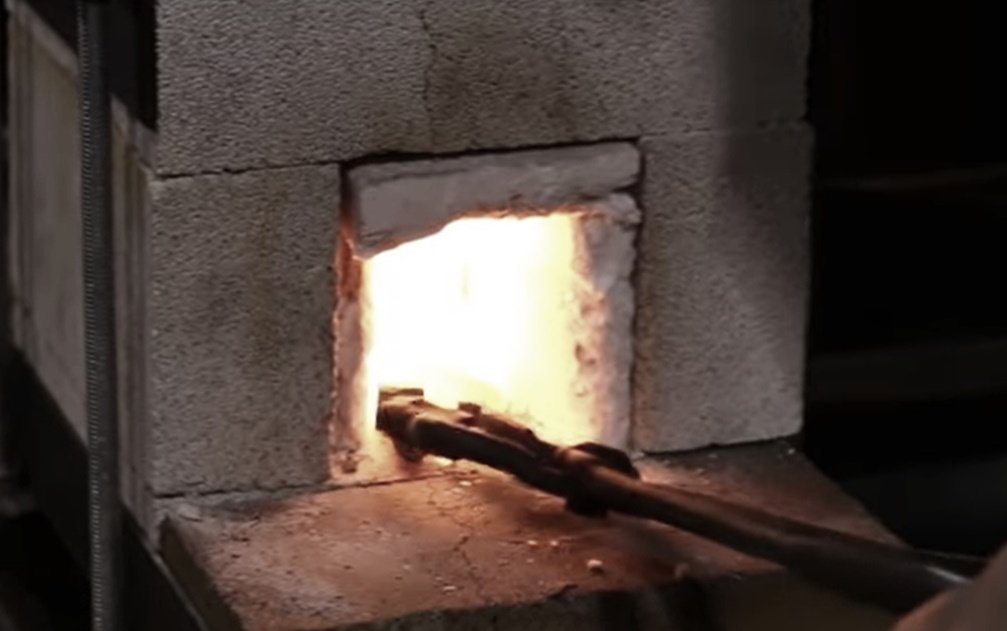
There are two ‘softening’ processes commonly used when metalworking: normalizing and annealing.
The objective of both processes is to soften the metal and to make it less brittle. This makes further work on the piece easier and safer.
What is Normalizing Steel?
Normalizing is the heating of steel to above its critical temperature followed by an air cool.
The piece is usually left somewhere warm (like near the forge).
Normalizing is a quick method of softening a piece to the point where you could heat treat (harden and temper) it for use.
What is Annealing Steel?
Annealing is the heating of steel to above the recrystallization point, followed by slow cool.
In steel, the recrystallization point is near, but below the critical temperature for the alloy being.
Annealing is often accomplished in a programmable furnace which cools at a set rate.
A cool in an inert insulation medium such as ashes, perlite or vermiculite also works well.
The piece should be buried in the insulation immediately after removing it from the forge.
When to use Normalizing vs. When to use Annealing
Normalizing is useful only for tools where you have not changed the cross-section much, as when grinding and filing to shape, rather than forging.
Also, normalizing is not good for any alloy with any kind of enhanced hardenability; it is really limited to plain carbon steels.
This is very important if you have drastically changed the cross section of a piece of tool steel.
This creates incredible stresses in the steel from the heat and hammering, normalizing will not remove enough of the stress to provide a safe tool.
If you are grinding a spring to a chisel shape, you can probably get away with normalizing.
If you forge it to shape, anneal. If in doubt, anneal!
Final filing and polishing before hardening and tempering is easiest when annealed, you can even straighten a slight crook, but try to keep from doing that, as you’ll introduce stress again.
Normalizing is also useful in mild steel if you have hammered a fine point on something and need to bend or drill it later.
The metal right behind where the taper starts seems to condense; when you try to bend it cold, it won’t!
Also, that same area will really screech a drill bit, normalizing is the answer here. Just heat to a light cherry, and lay it aside.
Cold rolled steel, if it is to be worked cold, also will need to be normalized.
We used to twist 3/16 square into a tight twist over 10 feet with a half inch drill and a vise, but the cold rolled had to be normalized first or it would refuse to twist very much, then snap!
Annealing and Normalizing FAQs
What is normalizing and annealing?
Normalizing and annealing are two softening processes commonly used when metalworking. Normalizing is the heating of steel to above its critical temperature followed by an air cooling. While annealing is the heating of steel to above the recrystallization point, followed by slow cool.
What is difference between normalizing and annealing?
The primary difference between the normalizing and annealing processes is that the normalizing process include a faster cooling process and is thus quicker. As far as results, the main difference is is that annealing makes the material more flexible, but less strong.
Does annealing increase grain size?
Yes, during the grain growth phase of the annealing process the grain size will increase. The annealing temperature and annealing time will determine the resulting grain size.
What is the main purpose of normalizing steel?
The main purpose of normalizing steel is to soften it and make it stronger, less brittle, and safer to work with. The heating and cooling process of normalizing removes impurities and changes the size of the grain to achieve this.


One of my cousins came over to hang out with me the other day and he mentioned that in his new job as administrative assistant he is in charge of finding different services that could help his own company with upcoming projects. He mentioned that currently he is searching for annealing and metalworking, and I became really curious about what this is used for. I liked that you said that annealing is the heating of steel to the point above recrystallization, and I would definitely love to learn more!